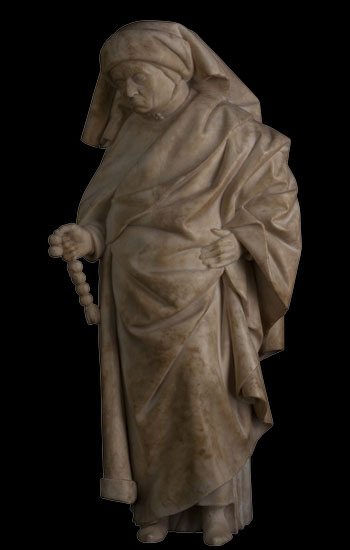By Bob Hicks
Like “a troop of fairy-tale dwarfs turned to stone by an evil sorcerer” — or so Ken Johnson describes them in his review this morning in the New York Times — they march, mourning the death of John the Fearless, Duke of Burgundy (1371-1419). These 16-inch-tall alabaster carvings, which these days do most of their weeping at the Musée des Beaux-Arts de Dijon in France, have traversed time and the Atlantic for a tour of seven American museums. Their first stop is Medieval Hall at the Metropolitan Museum of Art, where they’ve been since March and will stay through May 23.
 Johnson’s report caught my eye first for the gorgeous photo that the Times ran and then for the story’s mention that the tour was organized under the wing of FRAME (the French Regional and American Museum Exchange), the innovative organization of which the Portland Art Museum has been a leading and vigorous member. The almost forty alabaster carvings in The Mourners: Medieval Tomb Sculptures From the Court of Burgundy will move on to FRAME member museums in St. Louis, Dallas, Minneapolis, Los Angeles (the Los Angeles County Museum of Art), San Francisco and Richmond — but not to Portland.
Johnson’s report caught my eye first for the gorgeous photo that the Times ran and then for the story’s mention that the tour was organized under the wing of FRAME (the French Regional and American Museum Exchange), the innovative organization of which the Portland Art Museum has been a leading and vigorous member. The almost forty alabaster carvings in The Mourners: Medieval Tomb Sculptures From the Court of Burgundy will move on to FRAME member museums in St. Louis, Dallas, Minneapolis, Los Angeles (the Los Angeles County Museum of Art), San Francisco and Richmond — but not to Portland.
Why not?
To begin, none of the museums in this exchange, which includes a dozen leading French regional museums and a dozen in the United States plus one in Montreal, takes part in all of FRAME’s projects. Each museum picks and chooses the projects that fits its interests and schedule. The group isn’t without its politics (what is?) and it’s undergone considerable internal upheaval in the past several months, but at its best it’s a win-win for everyone, highlighting the considerable artistic resources outside of Paris and New York. (The Met isn’t a member of FRAME, but who says no to the Met?)
I asked Bruce Guenther, PAM’s chief curator, about the show and he said the Portland museum passed on Mourners “given collections here and limited slots” for exhibitions — a not surprising response.
Guenther also passed along some other news:
— He expects the search for a new curator of European art to begin late this fall and a hire to be made by March 2011. “The Geary Endowment will be positioned to support it by then and a number of projects will be starting,” he said. The museum announced a $2 million gift in March of 2008 from Janet and Richard Geary to endow the curatorship. At the same time it announced a $1 million gift from Laura Meier and the late Roger Meier to fund exhibitions and programs in European art.
— Guenther said PAM is still among the “most involved members in FRAME,” adding that the exchange is at a “leadership transition juncture that will be interesting to watch this summer.”
— Third: “We have another single masterpiece show in (the) works.” The last one, you might recall, was Raphael‘s 1516 portrait The Woman with the Veil, on loan last fall from the Palatine Gallery in Florence.
The hiring, at long last, of a new European curator will be a significant event. The post has been vacant since consulting curator Penelope Hunter-Stiebel and the museum parted ways shortly after Brian Ferriso took over as director from John Buchanan, who left for the Fine Arts Museums of San Francisco. Hunter-Stiebel brought both glamour and scholarly rigor to the position, beginning with the blockbuster Stroganoff exhibition of Russian treasures in 1999-2000 and continuing through many exhibits, both borrowed and original, up through the eye-opening La Volupte du Gout, based on art in the circle of Madame de Pompadour, and Rembrandt and the Dutch Golden Age, in collaboration with Amsterdam’s Rijksmuseum. She was a shrewd and enthusiastic participant in FRAME, and also spearheaded several key acquisitions that shored up the museum’s permanent collection and will leave her eventual successor with something solid to build on.
Would she have pushed for Mourning? Hard to say, and in the end, it’s not really a very important question. New administrations bring new agendas, and Ferriso has had to face far more parsimonious times than Buchanan did. The costs of international shows can be daunting, even when they’re shared, as they generally are on FRAME-originated projects. The insurance price tag alone on some international shows is enough to strike cash-strapped museums with fear and trembling. Still, having someone advocating for great European historical art will be a welcome return.
In the meantime, if you find yourself on the road, maybe you’ll get a chance to see this apparently remarkable exhibition of medieval carvings. Johnson, writing in the Times, had some sharp criticisms of the show’s layout and catalog. But he also quoted Johan Huisinga from his chronicle The Waning of the Middle Ages pronouncing these pieces “the most profound expression of mourning known in art, a funeral march in stone.” And Johnson elaborated: “If he was exaggerating, it was not by much.”
*
ILLUSTRATION: Mourner with hood folded back, holding a dizain with his right hand. Jean de La Huerta (Daroca, ? – ? After 1462) and Antoine Le Moiturier (Avignon, c. 1425 – Dijon, 1494). Alabaster; Musee des Beaux-Arts de Dijon.